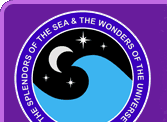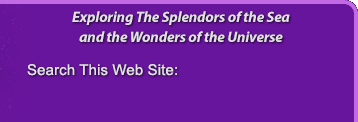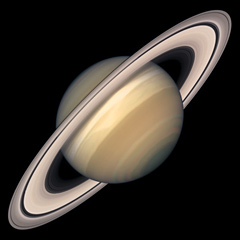 |
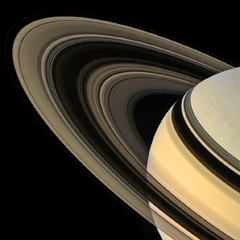 |
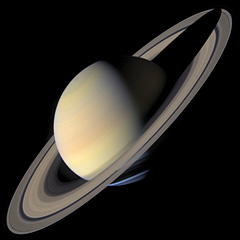 |
||
| Hubble high-resolution photo of the planet Saturn (NASA/JPL) |
Cassini close-up image of Saturn and its many rings (NASA/JPL/Space Science Institute) |
Cassini image showing Saturn's shadow falling across the rings (NASA/JPL/Space Science Institute) |
| Back to Previous Stop | Return to the Saturnian System |
Saturn | Continue Tour to Mimas |
Continue to Next Stop |
God of the Harvest
As we first enter the Saturnian system, we are presented with a sight of sheer beauty. It is a giant gas planet with a delicate system of silky rings. This is the planet Saturn. It is the sixth planet from the Sun and is the second largest in the Solar System. Saturn was named after the Roman god of agriculture and the harvest. His Greek counterpart was Chronus, the youngest of the Titans.
Many consider Saturn to be the most beautiful object in the Solar System. It is one of the brightest objects in the night sky, and has been known since prehistoric times. Galileo was the first person to observe Saturn through a telescope in 1610. He noticed the planet's odd shape, but was unable to figure out the significance of what he had seen. In 1659, Christiaan Huygens was able to correctly identify the odd shape as Saturn's rings. Since then, Saturn has been visited by three Spacecraft including Pioneer 11, Voyagers 1 and 2, and Cassini. The Cassini probe arrived at Saturn in 2004 and gave us spectacular new views of the planet and its moons. Saturn is surrounded by a small army of 82 known moons second only to Jupiter in number. Most of these moons are small, but seven of them are large enough to warrant further investigation.
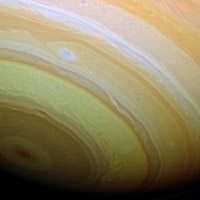 |
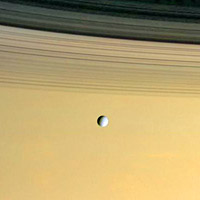 |
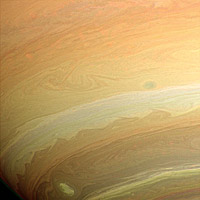 |
||
| Cassini false color image of Saturn cloud formations (NASA/JPL/Space Science Institute) |
Cassini image of the moon Dione orbiting above Saturn's rings (NASA/JPL/Space Science Institute) |
False color Cassini image of Saturn clouds and details (NASA/JPL/Space Science Institute) |
The Ringed Planet
Without a doubt the most striking feature of Saturn is its rings. Unlike the rings of Jupiter, which were not discovered until the Voyager 1 encounter in 1979, Saturn's rings have been known to exist since 1659. This is due to the fact that the ring system is quite large and bright. It can easily be seen from Earth with a small telescope. The view of Saturn's rings from Earth actually changes from year to year. This phenomenon occurrs because the tilt of Saturn's rings changes as it orbits the Sun. Because the rings are less than a mile in thickness, they seem to disappear completely every few years when they appear on edge as seen from Earth. This change in the ring system's orientation causes the brightness, or apparent magnitude of the planet to change as well.
Saturn has three main ring bands. They are identified as the A, B, and C-rings. A large gap can be seen between the A and B rings. This is known as the Cassini division, and was named after Giovanni Cassini, the discoverer the gap as well as four of Saturn's largest moons. It wasn't until the Voyager encounters with Saturn in 1980 and 1981 that the true mystery of Saturn's rings was unveiled. The ring system is really composed of seven rings with extremely complex structures. The larger rings are actually composed of many smaller ringlets. The Voyager probes also found strange radial, spoke-like structures in the rings. These are believed to be caused by dust particles. Saturn's innermost ring, the F-ring, appears to be knotted or braided. Astronomers are not sure yet what causes this strange phenomenon.
The Voyager probes revealed the existence of small moons in and near the rings. They are called "shepherding satellites" because they are believed to help keep the rings in place. Without the gravitation of these moons, the ring particles might fly off into space and the rings would be lost.
The origin of Saturn's rings is not well understood. They appear to be composed of millions of tiny particles of ice and rock, each in its own orbit around the planet. The size of these particles ranges from as small as a dust grain to as large as an iceberg. Astronomers believe that the rings could be the debris of one or more moons that were pulverized by asteroid or comet impacts.
 |
| This Cassini mosaic image shows that Saturn's stunning system of rings is much more complex than originally thought. They are composed of hundreds of smaller rings and gaps like the groves on a phonograph record. (NASA/JPL/Space Science Institute) |
Features of Saturn
Even though the ring system is Saturn's most striking feature, the planet is also interesting in a number of other ways. Saturn is a gas giant with a chemical composition very similar to that of Jupiter. It is composed of about 75% hydrogen and 25% helium, with traces of methane, water, and ammonia. Astronomers believe that Saturn's interior is also similar to that of Jupiter, with a core of rock and ice, surrounded by a layer of liquid metallic hydrogen. There is no solid surface on Saturn. Instead, the atmospheric gases get denser and thicker as they approach the planet's center. Saturn is also the least dense of all the planets. Its specific gravity is only 0.7, which is less than that of water. If Saturn could be placed into a giant container of water, it would actually float!
Saturn shares many other features with its close cousin, Jupiter, such as high winds and cloud banding. Winds at the equator can reach an unbelievable 1,100 miles per hour. The horizontal bands on Saturn are much fainter than those on Jupiter. The Hubble space telescope has also revealed that storms occasionally erupt in Saturn's turbulent atmosphere. Like most of the other gas giant planets, Saturn has a strong magnetic field. Like Jupiter, Saturn is visibly flattened at its poles. This is caused by the planet's rapid rotation of only 10 hours, 39 minutes. In July of 2004, the Cassini probe is scheduled to arrive at Saturn. It will orbit the planet and send back detailed images and data. It will also drop the Huygens probe into the atmosphere of Saturn's moon Titan. There it will land and sample the composition of Titan's thick atmosphere and send back images of the surface.
The Sun
Mercury
Venus
Earth
Mars
Jupiter
Saturn
Uranus
Neptune
Pluto
Asteroids
Comets
Interstellar Space
Your Weight on Other Planets
|
||||||||
The Moons of Saturn |
||||||
Name |
Pronunciation |
Order |
Diameter |
Orbital Period |
Distance |
Year |
|
S/2009 S 1 Daphnis Aegaeon Methone Anthe Pallene Polydeuces Kiviuq Ijiraq Paaliaq Skathi S/2004 S37 S/2007 S2 Albiorix S/2004 S29 Bebhionn Erriapus Skoll S/2004 S31 Siarnaq Tarqeq S/2004 S13 Greip Hyrrokkin Jarnsaxa Tarvos S/2006 S1 Mundilfari S/2004 S17 Bergelmir Narvi S/2004 S20 Suttungr Hati S/2004 S12 S/2004 S27 Farbauti Thrymr S/2004 S30 Aegir S/2007 S3 Bestla S/2004 S7 S/2004 S22 S/2004 S23 S/2004 S25 S/2004 S32 S/2006 S3 S/2004 S38 Fenrir S/2004 S28 Surtur Kari S/2004 S35 Ymir S/2004 S21 S/2004 S24 Loge S/2004 S36 S/2004 S39 S/2004 S33 S/2004 S34 Fornjot S/2004 S26 |
- PAN DAF-nis AT-lus pra-MEE-thee-us pan-DOR-uh ep-eh-MEE-thee-us JAY-nus ee-JEH-un MY-mas mi-THOH-nee AN-thee puh-LEE-nee en-SEL-uh-dus TETH-iss tah-LESS-toh ka-LIP-soh dy-OH-nee HEL-en-ee POL-i-DEW-seez REE-uh TY-tun hy-PEER-ee-un eye-AP-uh-tus KEE-vee-ookh EE-ye-rahkh FEE-bee PAH-lee-ahkh SKAH-thee - - AL-bee-OR-iks - BEV-een AIR-ee-AH-po SKOL - SEE-ar-nahkh TAR-kayk - GRAYP hirr-ROK-in yarn-SAKS-uh TAR-vos - MOON-dil-FAIR-ee - berr-YEL-mirr NAR-vee - SOOT-oong-er HAH-tee - - far-BOW-tee THRIM-er - EYE-irr - BEST-luh - - - - - - - FEN-rirr - SURR-ter KAR-ee - IM-ir - - LOH-gee - - - - FOR-nyot - |
1 2 3 4 5 6 7 8 9 10 11 12 13 14 15 16 17 18 19 20 21 22 23 24 25 26 27 28 29 30 31 32 33 34 35 36 37 38 39 40 41 42 43 44 45 46 47 48 49 50 51 52 53 54 55 56 57 58 59 60 61 62 63 64 65 66 67 68 69 70 71 72 73 74 75 76 77 78 79 80 81 82 |
0.3 28 7.6 30 86 81 113 179 0.5 397 3.2 1.8 5 504 1,062 25 21 1,123 35 2.6 1,527 5,150 270 1,469 16 12 213 22 8 4 4 32 4 6 10 6 4 40 7 6 6 8 6 15 6 7 4 6 7 3 7 6 5 6 5 7 3 6 5 7 6 3 4 4 4 6 4 4 4 6 7 6 18 3 3 6 3 3 4 3 6 4 |
0.47 0.58 0.59 0.6 0.61 0.63 0.69 0.69 0.81 0.94 1.01 1.05 1.15 1.37 1.89 1.89 1.89 2.74 2.74 2.74 4.52 15.95 21.28 79.32 448.16 451.77 -545.09 692.98 -732.52 -758.18 -758.71 774.58 826.44 838.77 844.89 -862.37 869.65 884.88 894.86 -905.85 -906.56 -914.29 -943.78 944.23 -949.63 -956.70 -985.45 -985.83 -1,008.45 -1,010.55 -1,022.82 -1,033.05 -1,048.54 -1,054.45 -1,054.78 -1,078.09 -1,087.84 −1,094.46 −1,100 −1,101.45 −1,101.99 -1,107.13 -1,148.82 -1,150.69 -1,153.96 -1,161.65 -1,211.02 -1,212.53 -1,220.31 -1,242.36 -1,245.06 -1,253.08 -1,254.15 -1,272.61 -1,294.25 -1,300.95 -1,319.07 -1,351.83 -1,403.18 -1,414.59 -1,432.16 -1,627.18 |
117,000 133,584 136,505 137,670 139,380 141,720 151,422 151,472 167,500 185,404 194,440 197,700 212,280 237,950 294,619 294,619 294,619 377,396 377,396 377,396 527,108 1,221,930 1,481,010 3,560,820 11,294,800 11,355,316 12,869,700 15,103,400 15,672,500 15,892.000 16,055,000 16,266,700 16,981,000 17,153,520 17,236,900 17,473,800 17,568,000 17,776,600 17,910,600 18,056,300 18,065,700 18,168,300 18,556,900 18,562,800 18,652,700 18,725,800 19,099,200 19,104,000 19,395,200 19,418,000 19,579,000 19,709,300 19,905,900 19,976,000 19,984,800 20,278,100 20,396,000 20,482,900 20,518,500 20,570,000 20,576,700 20,636,000 21,163,000 21,174,000 21,214,000 21,308,000 21,908,000 21,930,644 22,020,00 22,288,916 22,321,200 22,412,000 22,429,673 22,645,000 22,901,000 22,984,322 23,192,000 23,575,000 24,168,000 24,299,000 24,504,879 26,676,000 |
2009 1990 2005 1980 1980 1980 1977 1966 2008 1789 2004 2007 2004 1789 1684 1980 1980 1684 1980 2004 1672 1655 1848 1671 2000 2000 1899 2000 2000 2019 2007 2000 2019 2004 2000 2006 2019 2000 2007 2004 2006 2006 2006 2000 2006 2000 2004 2004 2003 2019 2000 2004 2004 2019 2004 2000 2019 2004 2007 2004 2004 2019 2019 2019 2019 2006 2019 2004 2019 2006 2006 2019 2000 2019 2019 2006 2019 2019 2019 2019 2004 2019 |
| Back to Previous Stop | Return to Saturnian System |
Return to Top of Page |
Continue to Next Stop |
